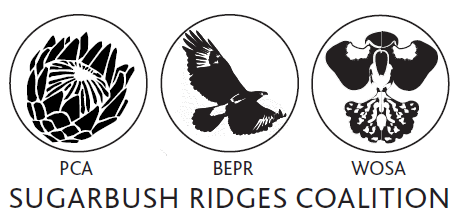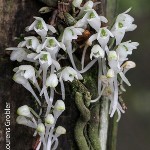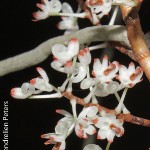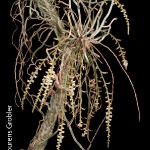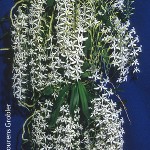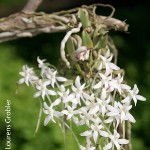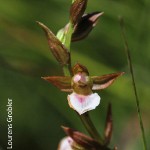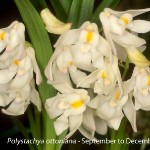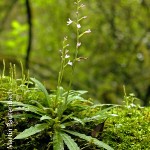Orchids by Genera
The South African Indigenous Orchids are listed below in alphabetical order starting with the genus and then following on with the species in alphabetical order under each genus. If you are looking for a specific genus use the list on the left and click on the genus. That will give you all species with that genus. Click on the little arrow to the left of the genus name in the list and a drop down box will give you all the species belonging to that genus. Here you can click on a specific species and get the information for that species only.
This section of the website is still under development. Please check back often for updates. We are still looking for photographs of some 200 of the 500 species and if you find a species description without a photograph and would like to contribute a specific photo for that species please contact us. All photographs are properly credited.
Margelliantha caffra
Description
Miniature epiphyte with stems up to 20mm. Leaves few or occasionally absent, linear to strap-shaped and unequally bilobed. Inflorescence lateral, one to several, hanging from below the leaves, up to 45 mm long. 5-15 flowers close to each other, which are white with a green anther cap. Previously allocated top the genus Mystacidium and Diaphananthe, before being recognised under the current genus name.
Microcoelia aphylla
Description
Slender leafless epiphyte, with stems up to 400 mm long and only 2 mm in diameter, climbing with hook-like roots. Inflorescences lateral, many all along the stem. 8-16 flowers are white, with contrasting, rust-red sepal tips. Column also rust coloured. Spur short and generally curled. Syn: Solenangis aphylla.
Microcoelia exilis
Description
Slender, leafless epiphyte, with stems up to 40 mm long and 3 mm in diameter. Roots numerous, branching and twisted, not attached tightly to the host. Inflorescences lateral, several and up to 150 mm long with about 50 flowers. Flowers are white, 1.5 mm in diameter. Sepals and petals similar.
Microcoelia obovata
Description
Slender leafless epiphyte with stems up to 30 mm long. Roots are usually well attached to the host. Inflorescences lateral, up to 10 simultaneously up to 90 mm long. Flowers up to 10, white with a yellow brown column and anther cap. Petals and sepals similar and egg shaped.
Mystacidium capense
Description
Slender epiphyte with stems of 10-25 mm long. Leaves strap-shaped, unequally bilobed, up to 120 mm long and 22 mm wide. Inflorescences lateral, one to several, up to 180 mm long, laxly flowered. Up to 13 flowers are white with a glistening texture, 25-30 mm in diameter, sepals and petals similar, linear to spear-shaped, spur tapering, up to 60 mm long. Similar to Mystacidium venosum. Pollinated by hawkmoths. Colony forming. Fragrance sweet, jasmine-like at night.
Mystacidium venosum
Description
Miniature epiphyte with stems 10-15 mm long. Leaves strap-shaped to elliptic, unequally bilobed, up to 45 mm long and 10 mm wide, often poorly developed or absent. Inflorescences, one to several, up to 50mm long,4-10 flowers, white and 15 mm in diameter. Petals and sepals reflexed, spur tapering, up to 45 mm long. Similar to Mystacidium capense, distinguished by different flowering time and shorter leaves and spur. Pollinated by hawk moths. Fragrance sweet, scented at night.
Neobolusia tysonii
Description
Slender terrestrial up to 400mm in height. Stem has a raised ridge along it's length. Leaves 2 basal, spreading, narrowly elliptic to oblong up to 155mm long, a few small sheathing leaves higher up. Inflorescence lax, up to 150mm long, with 2-12 flowers which have brownish green sepals, off white petals, white lip with pink markings at the base. Spur is absent.
Platylepis glandulosa
Description
Creeping terrestrial becoming erect, up to 500mm tall. Leaves evident only on the bottom half of the erect section, stalked with conspicuous veins, egg shaped, up to 50mm long. Inflorescence congested, ovoid, conspicuously hairy, up to 100mm tall. Flowers green to greenish brown and white, lip white. Median sepal forms a hood with the petals. This genus has only one species.
Polystachya ottoniana
Description
Very slender epiphyte or lithophyte, up to 150mm tall. Pseudobulbs adjacent, often forming long chains, conical, up to 25mm high. Leaves 2 or 3, linear to strap-shaped, up to 130mm long. Inflorescence lax, as tall as the leaves, simple and hairy, 1-5 flowers, cream or white, lip with central yellow marking. Sepals subequal; median sepal narrowly oblong up to 13mm long, lateral sepals 13mm long, petals narrowly spatula to spear shaped up to 11mm long, lip 3-lobed up to 12mm long, 8.5mm wide. Hybridizes with Polystachya transvaalensis.
Stenoglottis fimbriata
Description
Slender epiphyte, lithophyte, or terrestrial, which can grow up to 400mm tall. Leaves 6-10 in a basal rosette, strap-shaped to narrowly spear-shaped, spotted, with wavy fringes. Inflorescences lax, 5-30 flowers, which are lilac with darker spots. Sepals similar and up to 8mm long, petals are shorter and enclose the column. Spur absent. A very variable species in size and colouration. The fleshy, hairy roots attach themselves onto quite steep rock faces, preventing excess water and debris accumulating. Colony forming.
For more information regarding the preservation of South Africa's wild Orchids or if you would like to get involved please email This email address is being protected from spambots. You need JavaScript enabled to view it. or complete this short form Contact Us and we will contact you.
